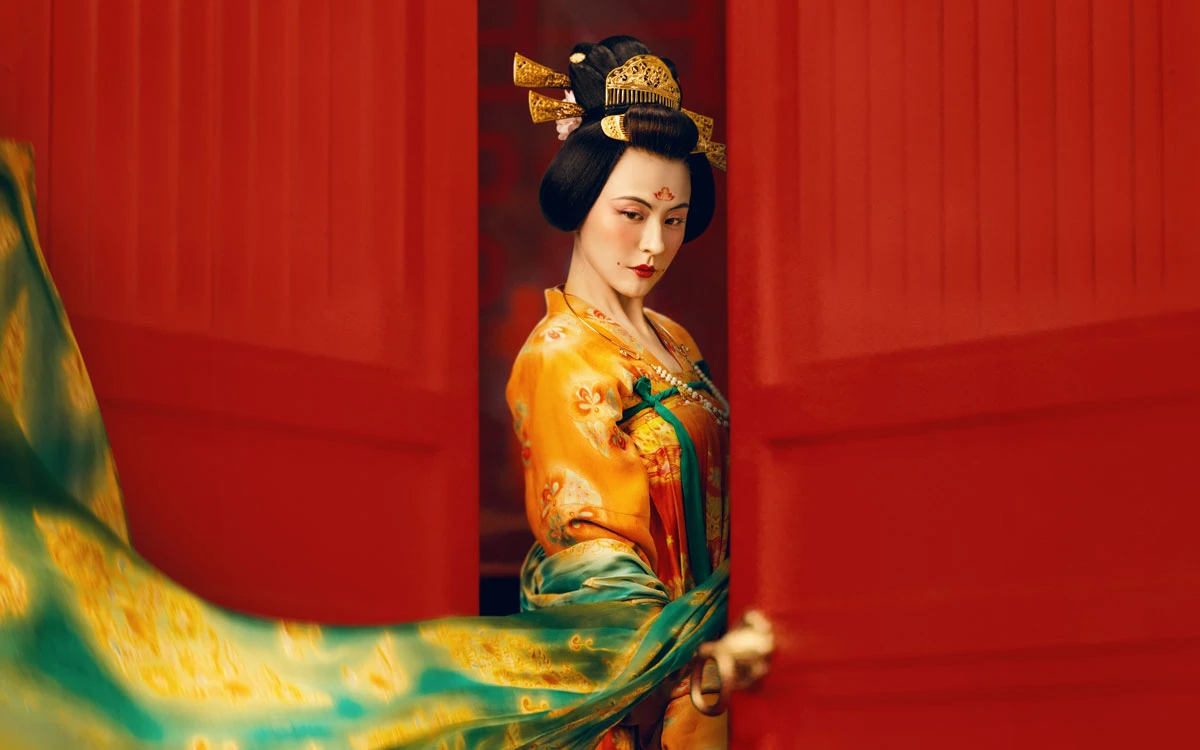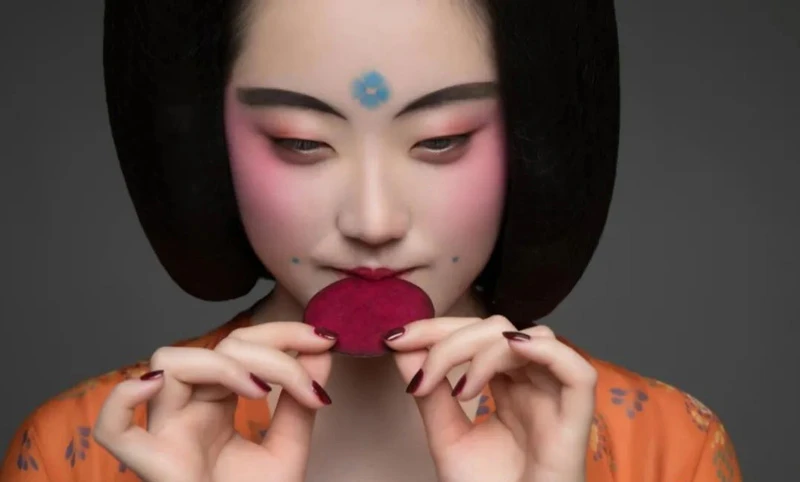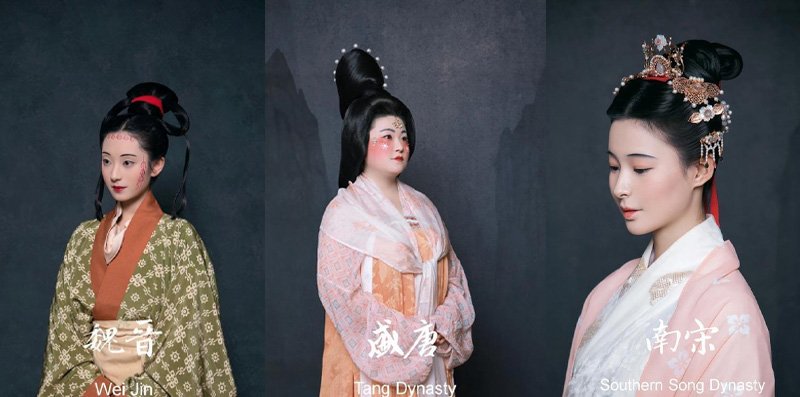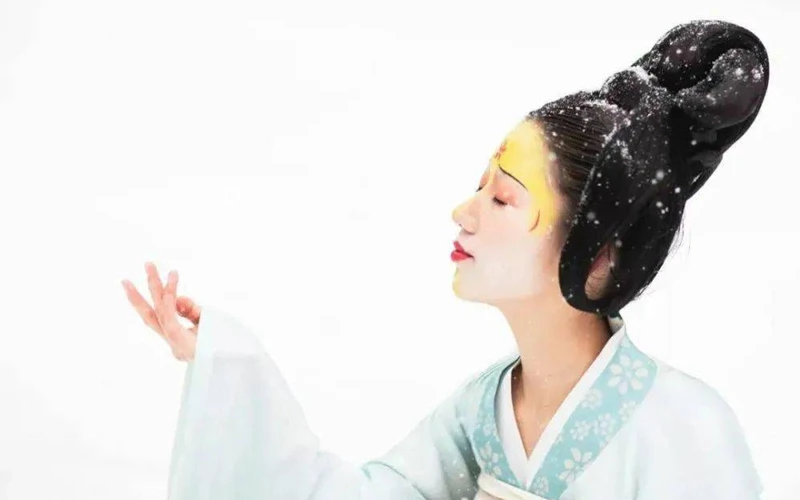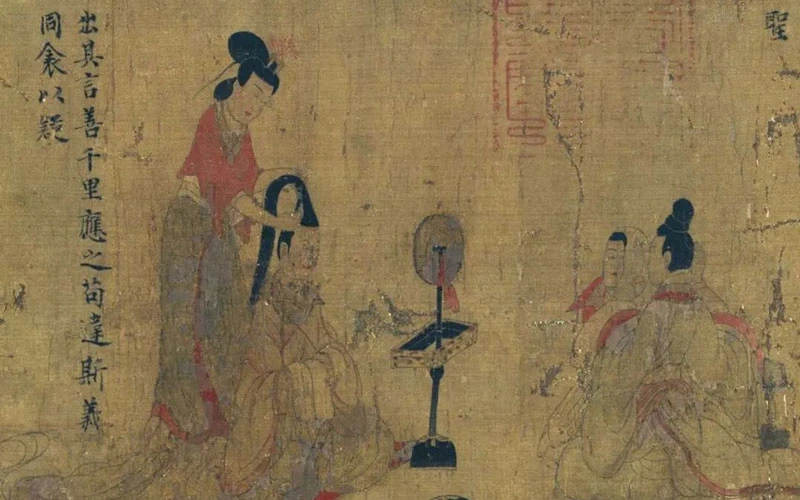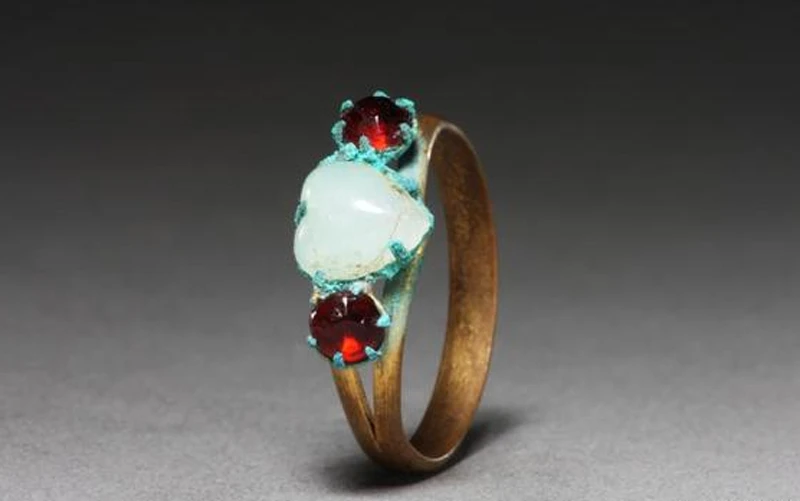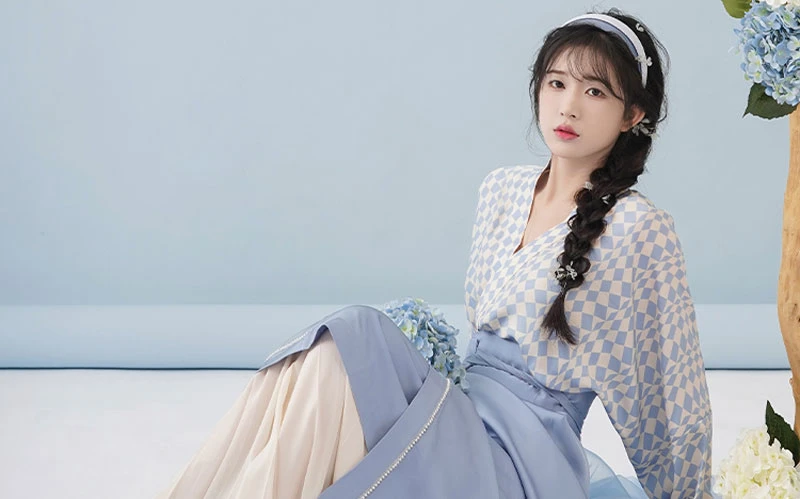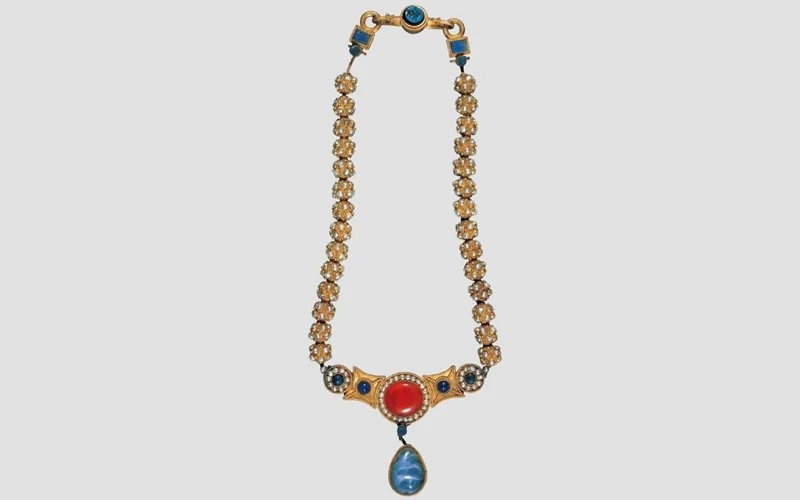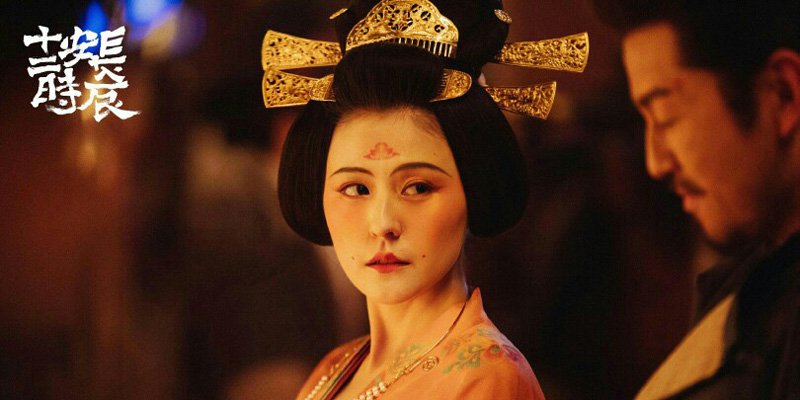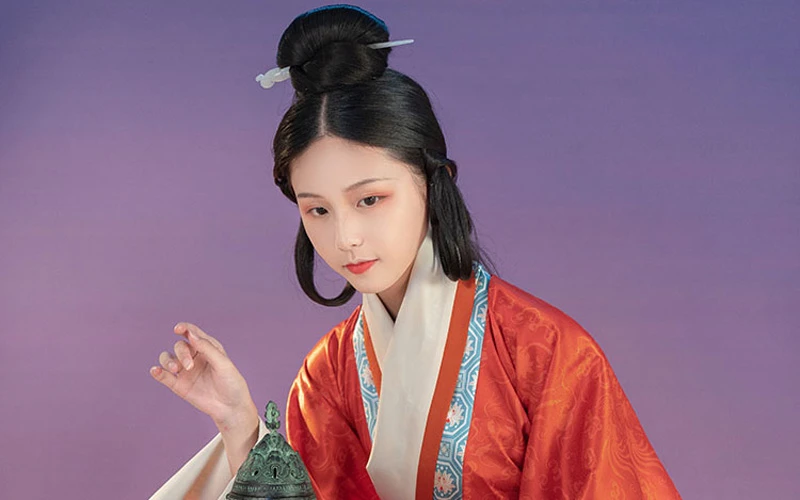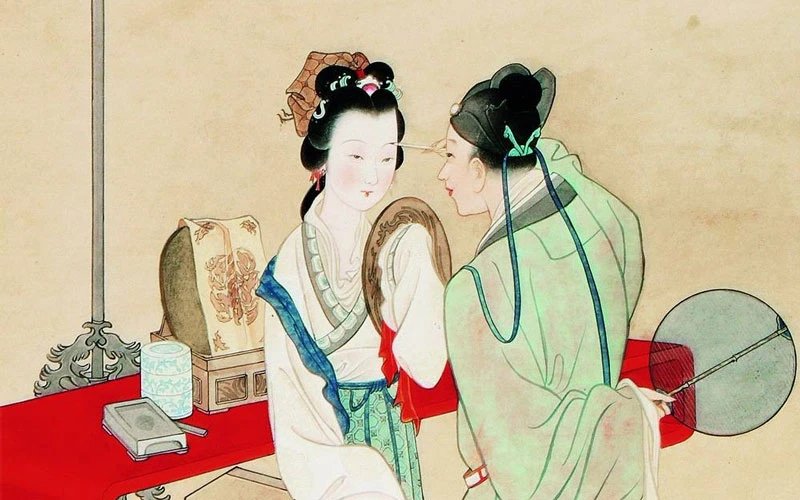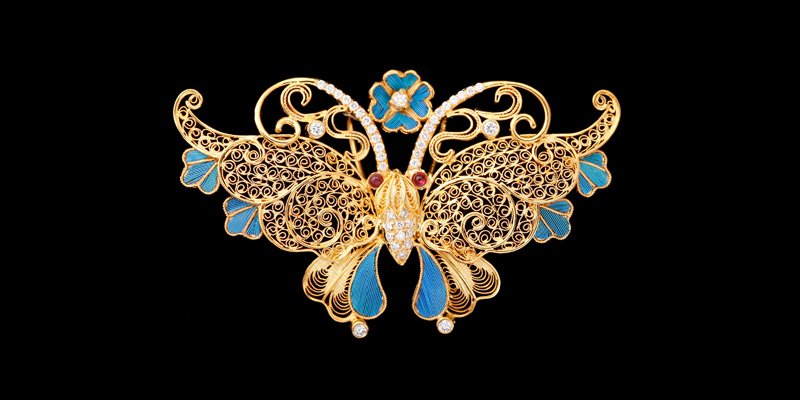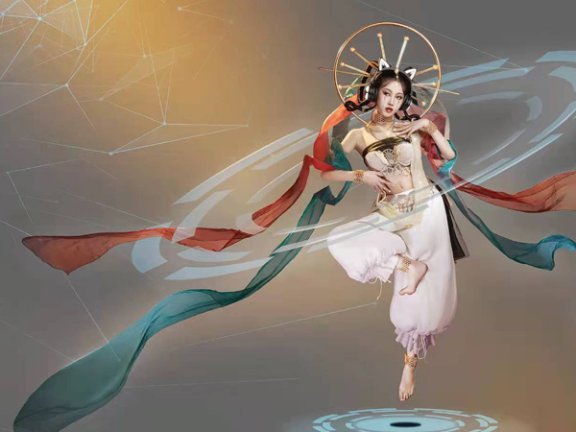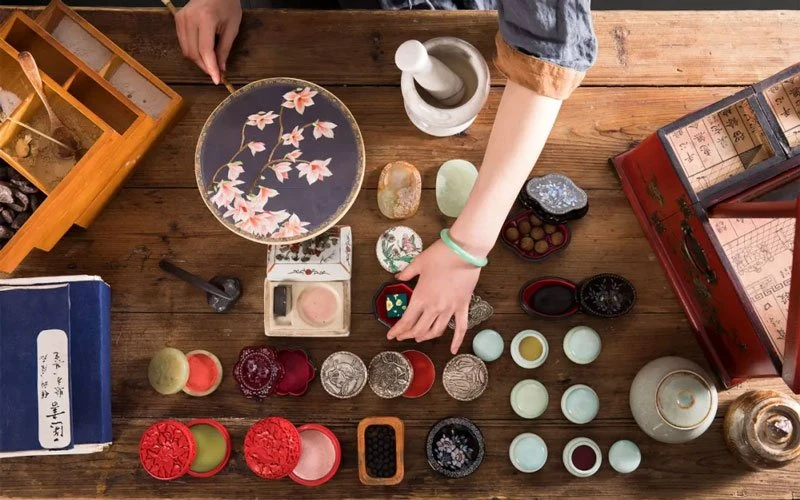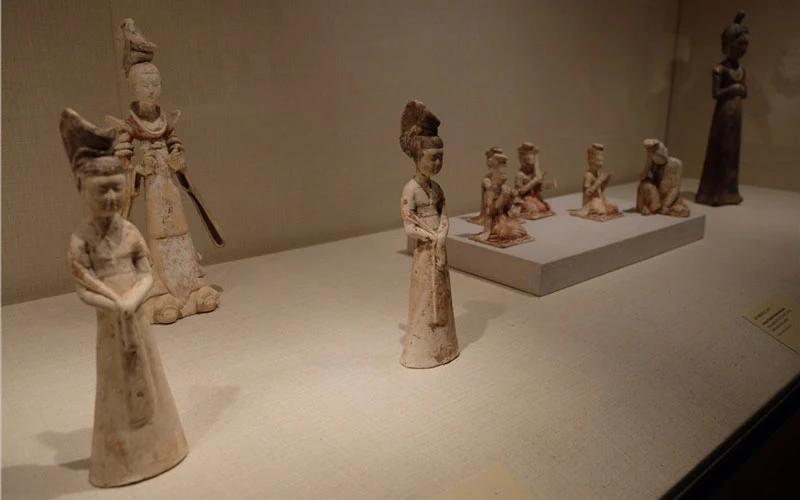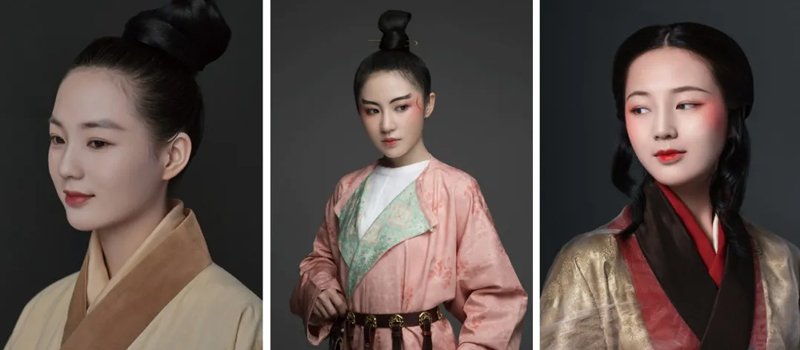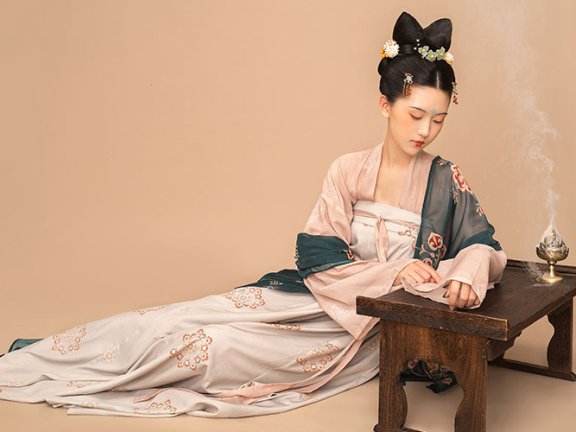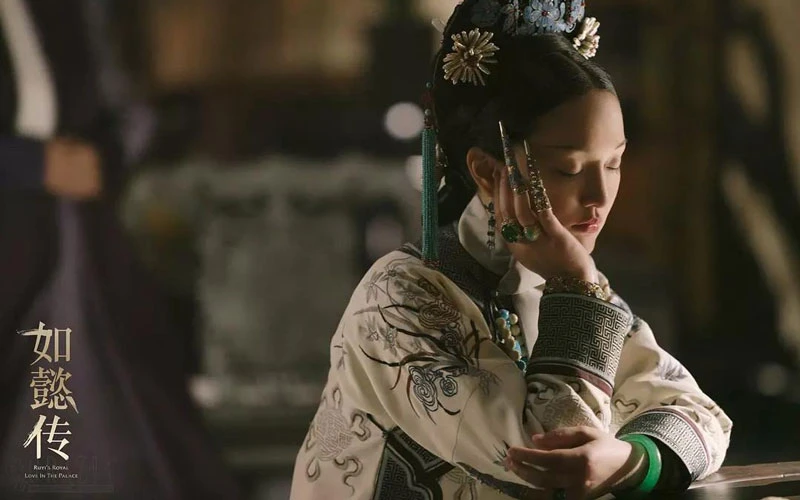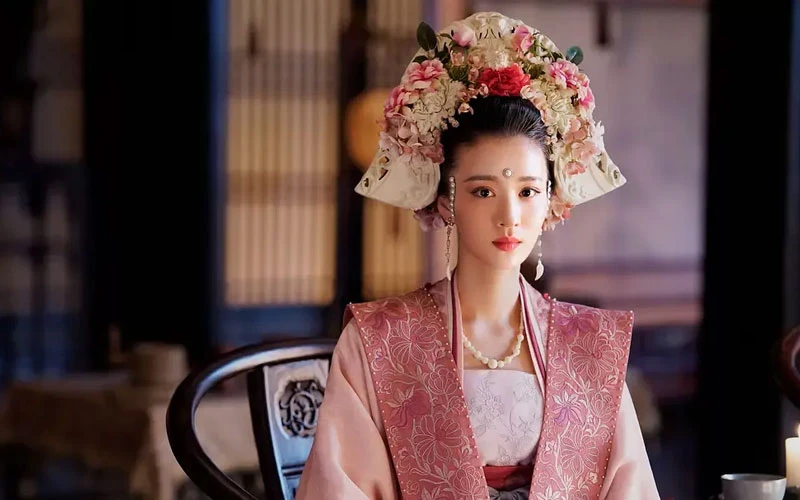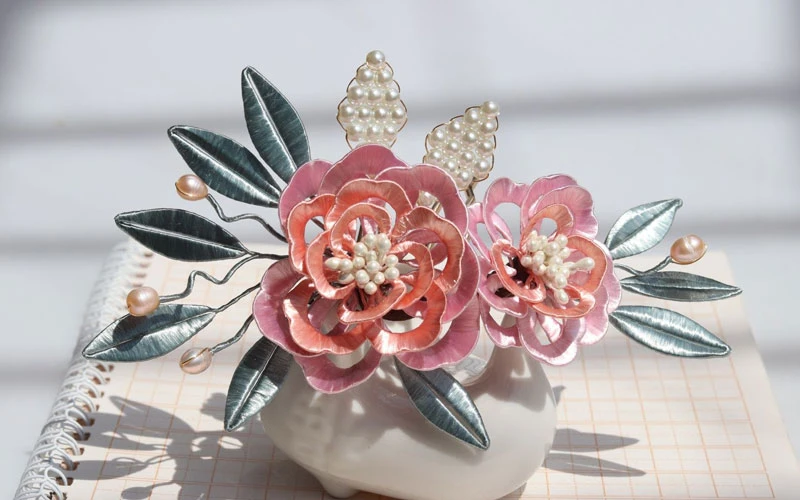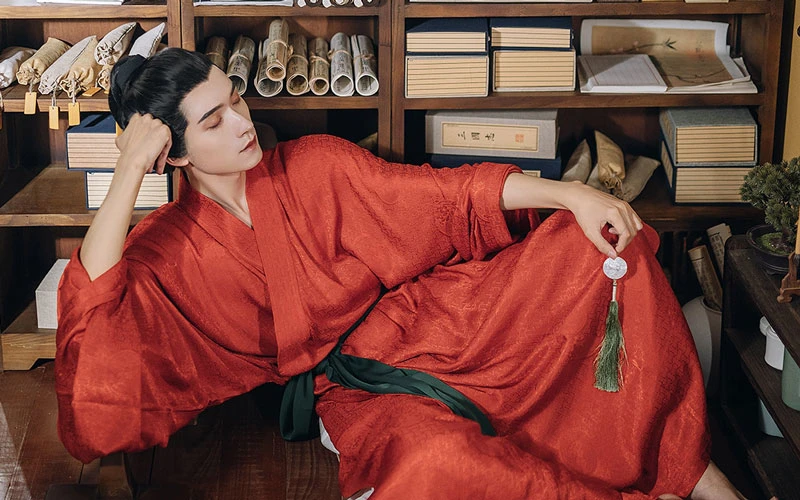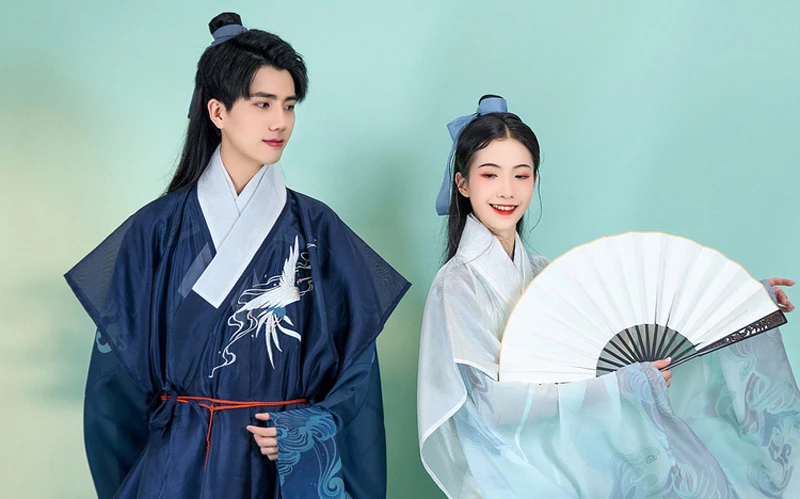-
Detailed Introduction of Tang Dynasty Female Hairstyles
The pursuit of beauty is human nature. Beauty is not only a reflection of the mind, but also a reflection of the interest in life. Tang Dynasty women are the best representatives of beauty, because they inherited the mentality of "Dress up for those who like or admire yourself (女为悦己者容)" from ancient times, and pushed the beauty ideal realm to the highest level under the booming economy and the open and tolerant social atmosphere. Lively, dignified, noble, the endless types of Tang Dynasty female hairstyles, paired with exquisite makeup, made many literati and scholars unstinting in their talent to depict the Tang women's style. Let's follow ArtMoment to go back thousands of years ago, and enjoy the beauty of Tang female hairstyles in that remarkable era of spiritedness. Ancient Hairstyle Tips What are Ji and Huan? The ancient Chinese women's hairstyle is commonly known as Ji Huan (髻鬟, jì huán), and according to the method of combing, there are two types of Ji (髻, jì) and Huan (鬟, huán). Ji, solid hair bun, suitable for ordinary women; Huan, ring-shaped hair bun, suitable for young girls. What does the change of hairstyle mean? In ancient China, a woman's hairstyle changed with…- 3
- 3
- 4.9k
-
Mid Tang Dynasty Makeup Features - Alternative Aesthetics
In the middle of the Tang Dynasty, women's hairstyle, makeup, jewelry, and dress style has undergone a huge change. Heavy makeup and high buns, long skirts with large sleeves prevailed, and formed a variety of distinctive makeup styles. At first, it was just regarded as grotesque, considered to be a sign of chaos, but later it developed into an issue discussed in the court. Although prohibited by the court, it is difficult to extinguish, getting more and more intense. Shi Shi Zhuang During the Zhengyuan period (785-805), the Ti Mei makeup (啼眉妆) and the Duo Ma bun (堕马髻) appeared first. The prototype of the bun hanging on one side already appeared during the Kaiyuan period, but it evolved into more huge and exaggerated in the Middle Tang Dynasty. The eyebrows painted in the shape of characters "八", replaced the previous curved thin eyebrows. The female figurines excavated during the Zhen Yuan period and the ladies of the "A Palace Concert" all showed such kind of makeup style. On this basis, the famous Shi Shi Zhuang (时世妆) was formed during the Yuanhe period (806-820). Bai Juyi, who loved to record the details of the costumes, depicted this makeup detail in…- 1
- 2
- 1.1k
-
Tang Flourishing Period: the Age of Yang Guifei’s Heavy Red Makeup
To choose a representative of ancient Chinese beauty, Yang Guifei (杨贵妃/杨玉环, Yang Yuhuan) would probably be one of the most highly acclaimed candidates. As one of the Four Beauties, her romantic legend with Emperor Xuanzong has been repeatedly sung, and anecdotes about the consort and written accounts of her appearance, as well as related paintings, operas, and theatrical stage performances, are commonplace. For thousands of years, literati and people have been curious about the beauty and makeup of the consort. What is the real makeup style of Yang Guifei? If we only speculate from the descriptions of later texts, we may not get the real results. Aesthetics are always changing, and the benchmark for judgment is also changing. But large-scale archaeological excavations over the past half-century or so, especially the hundreds of realistic ceramic figurines, murals and silk paintings unearthed in the tombs of nobles during the Xuanzong era, have allowed us to scientifically summarize the aesthetic tendencies and changes in the figure and makeup of noblewomen during the decades of the Tang dynasty, Kaiyuan (开元), and Tianbao (天宝). Among them are many court paintings of Yang Guifei during her stay in the palace, which is generally available for reference…- 3
- 3
- 1.1k
-
Features of Traditional Makeup in Various Ancient Chinese Dynasties - Part I
In ancient China, based on different social backgrounds, there are different styles of hanfu clothing between dynasties, women's traditional makeup will also vary, this article will share the characteristics of the makeup of women from the Warring States period to the Song Dynasty for you. 01 Warring States Warring States period makeup is mainly light and elegant makeup, the society at that time advocated the virtue of beauty, so the simple makeup became the mainstream, the overall give a sense of nature without powder, to be able to fully show the five features and the advantages of the face shape. 02 Western Han and Eastern Han Western Han and Eastern Han period makeup is also more characteristic. Western Han Dynasty, the biggest feature of women's makeup is lip makeup, lip makeup halo area is small and concentrated in the location of the lip beads, so it will give a sense of biting the lips, coupled with thin eyebrows, looks classical charm. The makeup of the Eastern Han period is significantly different from the Western Han period, where the eyebrows were replaced with thicker eyebrows, and both sides of the cheeks will be stained with blush, compared to the…- 1
- 3
- 1.3k
-
Early Tang Dynasty Female Makeup History
As for the most powerful woman in ancient China, Wu Zetian must be mentioned. From the time she entered the palace to the time she abdicated, Wu Zetian's life spanned nearly seven decades from the early Tang Dynasty to the peak of the Tang Dynasty, nearly a quarter of the reign of the Tang Dynasty. With the overall national power, economy, customs, and even climate change of various factors, this period of court makeup, whether the overall aesthetic, or makeup, hair, jewelry, and even clothing, have undergone huge changes. As a woman who eventually rose to the top of imperial politics, Wu Zetian had the powerful energy for changing the makeup fashion of the day. 01 From the simple charm of the old dynasty Wu Zetian was born in the seventh year of Wu De (624), and entered the palace at the age of fourteen in the eleventh year of Zhenguan (637). After twelve years as a concubine, she followed the other concubines without children into the Temple of Sensationalism as a nun. The style of Tang women's clothing in the Zhenguan period was similar to that of the late Northern dynasty and Sui, advocating a slender figure and…- 0
- 4
- 814
-
10 Types of Wei and Jin Periods Hanfu Makeup
"The six dynasties of the late Han, Wei and Jin dynasties were the most chaotic and socially painful era in Chinese history, yet one of the most spiritually free and liberated, the richest in wisdom and passion, and therefore the richest in artistic spirit." Due to the decline of Confucianism and the rise of Xuanxue, both men and women in the Wei and Jin dynasties sought to express their superior inner personality with a beautiful external appearance. In addition, Buddhism was spread to the east, the exchange of migration between north and south brought about a broadening of horizons. As well as the harem beauties, the number of dancers is vast, must be unique makeup to attract attention, so all the reasons contributed to the Wei Jin and North and South Dynasties on the explosive development of makeup. This development is due to the thin burial of the number of makeup artifacts, mostly presented in the level of written records so that we will call this period the peak era of makeup at the documentary level. This article brings together 10 classic Hanfu makeup looks from the Wei and Jin dynasties. Through them, you can get a glimpse of how…- 2
- 1
- 1.8k
-
History of Wigs in Ancient China
When you browse through the tutorials of hanfu hairstyles, you will find that the use of wigs is widespread. Is it true that girls had long and dense hair in ancient China? The eternal problem of thinning hair is not only a problem for modern people, but ancient beauties also needed to rely on wigs to complete the look. The application of wigs has a history of thousands of years. Today we briefly introduce the history of wigs. Di (髢, dí) and Bi (髲, bì) were the original names for traditional Chinese wigs. However, not everyone had access to wigs in ancient China. At the beginning of the wig's birth, it was not an ordinary accessory. The Rites of Zhou records that Zhuishi (追师), a kind of palace official in charge of the empress' headdress, made wigs and headdresses. 追师掌王后之首服,为副编次追衡笄…… ——《周礼》 Fu (副), Bian (编), Ci (次) are three different levels of wig types, only worn during critical events such as rituals, and only for the exclusive use of noblewomen such as empress and madam. The famous Mawangdui Han tomb has unearthed a well-preserved "Fu" wig. This set of wigs is thick and black, and Lady Xin Zhui chases…- 0
- 1
- 1.6k
-
History of Chinese Traditional Rings
For thousands of years, the Chinese have used rings to symbolize essential events, births, deaths, weddings, anniversaries, etc. The rings are generally worn by the oldest person present and passed down through generations. While the modern ring represents romantic love and commitment, what are the symbolic meanings of the traditional rings in Chinese history? Let's go into the past life of the ring. Ancient - The Ring of Bone More than 5,000 years ago, when humankind was still in its primitive society, the "ring" was already born. At that time, it did not have an exact name, but was just a ring-shaped object worn on people's fingers. In 1959, archaeologists found twenty traditional rings in the burials of the Dawenkou Longshan culture in Tai'an, Shandong province. Several of them are still worn on the finger bones of the deceased. These rings were made from natural animal bones, tooth bones, jade, etc. Although the process was simple, they were well made, and the surface was polished smooth, and some were inlaid with turquoise. This is the earliest "ring" found in China. It appeared in people's daily lives before records about it in history books. Yin Shang - The Ring…- 1
- 3
- 3.9k
-
4 Simple Hanfu Hair Styles to Match Modern Hanfu Easily
Many hanfu lovers have been confused about how to choose the right hanfu hair style to match their hanfu. Overly complicated hanfu hair styles mean tedious steps and long hours of preparation. But retro hanfu hair styles are not the only option. In fact, more and more hanfu lovers are choosing to match their hanfu with more stylish and simple hairstyles, especially when wearing modern hanfu style. In this way, hanfu can gradually integrate into modern society while retaining its traditional cultural connotations. Let's take a look at four modern hanfu hair styles that easily go with your hanfu, as shared by Yi Zhi Keke. 01 Low Coiffure Hairstyles Hairstyle features The back of the head coiffure is very simple, just tie a ponytail at the back of the head, then twist it into a clockwise circle and wind it up. If you think the modeling is too monotonous, you can also insert a hairpin, or coiffure hair band together with the coiled in, which will make the overall modeling more gentle and soft, but also with a little mature woman's charm. This kind of coiffure is most suitable with curtain bangs, so that both romantic style, but also… -
History of Chinese Traditional Necklace & Choker
The ancient women left their stunning figures in the ancient poets, and their bejeweled were equally eye-catching. That brilliant hanfu jewelry like a river of stars, will set them off quiet, elegant, highlighting the unique charm. In this article, let's go into the history of gorgeous Chinese traditional necklace and choker and see how the ancient people carried forward the beauty of neckwear. The Ancient Times When our ancestors were still living in cold, dark caves, the sense of beauty was already awakened. They searched for anything that resembled "beads", drilled holes in them, strung them on chains, and wore them around their necks. Some of them were also painted red with hematite powder. At the Zhoukoudian Peking Man site, which is about 30,000 years old, a large number of neck ornaments have been unearthed. These neck ornaments are made of different materials, including gravel, animal teeth, fish spine bones, and bird bones, all of which have been carefully selected and polished. Among them, there is a string of rabbit bone chains, consisting of 12 pieces of rabbit backbone, each of which has a hole for threading. The holes have been worn out and deformed due to long-term wear,…- 1
- 4
- 1.7k
-
Fashion’s Cycle Chinese Ancient Makeup Apply in Modern Look
From ancient times to the present, from China to overseas, makeup fashion has been a cycle, such as the traditional makeup that once faded in history, can now not only appear in the restoration works of Chinese ancient makeup lovers, but also can occasionally encounter in the major international shows. Today, take stock of those makeup looks that have traveled through the millennia for you. Buddha makeup In the Liao Dynasty, Khitan women often used yellow powder on the face, looking like a gold-coated Buddha statue, called the Buddha makeup. Until modern times, there are often similar makeup, all coated with gold "eighteen bronzemen" type, there are also fashion bloggers with yellow, gold makeup embellishment. Guang Mei makeup Guang Mei (广眉), also known as "Broad eyebrows". This eyebrow shape eyebrow long into the temples, appeared in the Western Han Dynasty, prevalent in the Tang Dynasty. The "Book of the Later Han" records that: "Broad eyebrows were popular in the city, and people drew eyebrows halfway up their foreheads" This shows how exaggerated these eyebrows were at that time. This exaggerated eyebrow shape that occupies half of the forehead is rarely seen in modern times, only in the show…- 1
- 4
- 783
-
History and Features of Traditional Han Dynasty Makeup Look
The Han Dynasty was the longest feudal dynasty in ancient China after the great unification of the Qin Dynasty. More than four hundred years of the Han Dynasty laid a solid foundation for Han, Hanzi, and Han culture. The same is naturally true in traditional Chinese makeup history. Overall, the core ideas that influenced women's aesthetics during the Han Dynasty were the ideas of Taoism and New Confucianism. The former had the greatest impact on the early and mid-Han Dynasty. The policy of "Recover from a Social Upheaval and Restore Production and Develop" was implemented by the rulers in the early Han Dynasty. Taoism's "Huang–Lao political ideology" responded to this social demand. Focused on the development of natural and "Wu Is the Origin ideas", while advocating an open, positive atmosphere, had a profound impact on the aesthetics of female makeup in this period. 01 Han Dynasty Makeup powder Compared with the pre-Qin dynasty, makeup powder in the Han dynasty had a great development. The powder for the face was based on rice powder, and with the rise of alchemy in the Qin and Han dynasties and the improvement of smelting technology in the Han dynasty, lead powder appeared and became…- 2
- 1
- 2.8k
-
History of Traditional Chinese Eyebows Makeup - Material & Shape
The history of traditional Chinese eyebrows makeup can be traced back to the Spring and Autumn Period(770 to 476 B.C.). There is a verse in "Chu Ci" that says "Black-painted eyebrows and white-powdered cheeks(粉白黛黑,施芳泽之).", which means that women were wearing powder, drawing eyebrows and rouge at that time. Traditional Chinese Eyebows Tools Eyebrow tools are crucial. Unlike modern eyebrow pencils, eyebrow powders, eyebrow cream, etc., there are a wide variety of tools to choose from. But the ancients were still creative with their limited tools. Before there was a specific material for eyebrow painting, Dai (黛), it was mainly used to draw eyebrows with burnt willow sticks, which women used to burn and apply to their eyebrows. The earliest material used to paint eyebrows was Dai, a black mineral also known as "Shi Dai (石黛)". Stone inkstones for grinding stone Dai are found in Han tombs, which means that this cosmetic was already in use in the Han Dynasty. Before paint eyebrows, stone Dai had to be ground on the stone inkstone to make it into powder, and then water was added to mix it. In addition to black color, there is also a dark gray material for painting…- 2
- 1
- 3.3k
-
History of Chinese Traditional Filigree Inlay Art
The magnificent filigree inlay, representing the pinnacle of precious metal production technology, from the old days dedicated to the court, to nowadays spread to the folk, there has been a lot of people contact, wear filigree inlay products, and for its exquisite and intricate technology by. What is Filigree Inlay? Filigree inlay (花丝镶嵌), also known as "fine gold craft", is a long-established traditional Chinese handicraft technique, mainly used in the production of ancient Chinese royal jewelry, by the combination of "filigree" and "inlay" two production techniques. Filigree refers to drawing gold and silver into fine wire, using filling and weaving techniques to make crafts. Inlay refers to the hammering of gold and silver flakes into vessels, and then burin out the pattern, set with pearls or gemstones, and become. As one of the "Eight Unique Skills of Yanjing", the art of filigree mosaic was included in China's national intangible cultural heritage list in June 2008. The objects that can be applied with filigree inlay can be divided into three categories. The first category is jewelry, including bracelets, necklaces, earrings, brooches, pendants, cufflinks, etc. The second category is the display category, mainly indoor decorative items, such as hanging scroll, vase,…- 3
- 6
- 1.5k
-
Hanfu in 2077? Post-95 Girl Made Cyberpunk Style Chinese Clothes
The inspiration for this set of photos came from a Qing Dynasty Qianlong porcelain now in the National Museum of China. It was made in Jingdezhen for Haiyan Hall in the Yuanmingyuan Park, and only one survives. The whole artwork contains the meaning of "the sea is calm and the river is clear, and the country is peaceful", and is beautifully crafted and painted, symbolizing the peak of the Qianlong period porcelain! On top of that, this blogger combines traditional elements with cyberpunk style, combining ancient national treasures with futuristic science fiction, a cyan Qing costume, a beautiful Tian-tsui crown, and golden nail guards to show luxury! The focus is on some details of the face, the appearance of the two swallows decorated, the face of the painted lines are all exquisite and sharp, just a few strokes to highlight the taste of the future of technology! Such a creative realization, the effect is really great! And this is not the only wonderful work of this treasure blogger, today we will introduce you to @Lao Ba (老八捌) and her fantastic creations! Hanfu + Futuristic Elements Ideas The idea of combining traditional hanfu with technology and the future has been…- 5
- 3
- 2.2k
-
What is Traditional Chinese Makeup?
The history of Chinese women's make-up is very long. After the rotation of dynasties, the traditional Chinese makeup has changed with the development of the times, reflecting the changes in customs and thoughts in each era. We will prepare a series of articles to introduce traditional Chinese makeup. Ancient traditional Chinese makeup Throughout the ages, women have different ways and methods to make themselves more beautiful. Compared with the modern, ancient women are more conservative and implicit, but they also have their own set of "secret weapons". As early as in the cultural relics unearthed in the Warring States period, it can be seen from them that at that time, women had the habit of thrushing and use rouge. That is to say, more than 2000 years ago in China, cosmetics had appeared. Of course, ancient China was an agricultural society, always in a state of self-sufficiency, and cosmetics were no exception. At that time, cosmetics were mainly made of pure natural plant and animal oils, and some natural spices were added. The general production process includes boiling, fermentation, filtration, etc. compared with the modern cosmetics production process, it is still relatively simple. Therefore, compared with modern women, ancient…- 5
- 2
- 11.2k
-
A Guide to Identifying the Hairstyles of Tang Dynasty Female Figurines
In museums, we can often see many female figurines from the Tang Dynasty. In this article, we will select some of the common female figurines to introduce their hairstyles. Duo Ma Ji (堕 马 髻) Duo Ma Ji is perhaps one of the most familiar hairstyles of the Tang Dynasty. In fact, this name already appeared in the Han Dynasty, but the exact form of Duo Ma Ji in the Han Dynasty is still uncertain. The name was used during the Tang Dynasty to describe a bun that was tilted to one side. The shape of the Duo Ma Ji is the hair falls between the ears and is combed towards the face, and the bun is not located in the middle of the head, but to the side. It is also known as the "Pao Jia Ji". This kind of bun is especially common in the late Tang Dynasty. In the famous "Lady Guoguo's Spring Outing", you can see the image of woman wearing the Duo Ma Ji. Wo Duo Ji (倭堕髻) Wo Duo Ji also has the form of double sideburns holding the face, with single or multiple buns placed on top of the head from…- 0
- 3
- 2.7k
-
The Evolution of Traditional Chinese Makeup Culture
About the ancient Chinese women's makeup, how ancient women actually groomed themselves? We don't really know. History has left many questions about traditional Chinese makeup: What did the real Yang Guifei look like? How did the pearl makeup of the Northern Song Dynasty evolve? What do the Ehuang, Huadian, and Yuanshan eyebrows refer to? In August, the book "The Beauty of Chinese Makeup (中国妆容之美)" was published. The book shows the makeup of women from the pre-Qin Dynasty to the Qing Dynasty, in which 29 groups of real restored makeup charts are particularly eye-catching, from hair to jewelry, from lip color to eyebrow shape, every detail, after informative testimony. One of the authors of this book, Chen Shiyu (陈诗宇), who is the costume consultant for National Treasures and Serenade of Peaceful Joy, has been engaged in the research of ancient Chinese costume restoration and crafts research for more than ten years. In his eyes, the process of restoring ancient figures looks is like solving a case, complicated but fun. In the program "National Treasure", Princess Wencheng played by Yang Zi and the Ya Ya played by Tong Liya, broke the inherent impression of people for the women of the… -
Collection of Ancient Chinese Makeup Style (Each Dynasty)
Time passes, in the millennium of Chinese history, each dynasty has evolved a unique style of women's makeup. As the saying goes, light makeup is always appropriate, nowadays we, and then see these exquisite ancient Chinese makeup style, will also be very amazed. The simple elegance of the Han dynasty, the ebullience of the Six dynasties period, gorgeous opulence of the Tang dynasty, each dynasty has its own representative style and unique aesthetic, today for you to take stock of the beauty of the ancient Chinese makeup style of each dynasty. Han Dynasty Han Dynasty women advocated "white powder and black Dai (黛, Greenish-black pigment used to paint eyebrows.)", but due to the constraints, they often used natural "cosmetics" to decorate their faces, such as finely ground rice grains to put on the face, this foundation is more healthy, but the effect of whitening is not obvious; many women even chose lead powder to put on the face, this mineral powder is toxic, but it has a strong whitening effect. With a white face, the next most important thing is to draw eyebrows. The common tool used by the ancients to draw eyebrows was "Dai", which was need dissolved…- 5
- 2
- 10.1k
-
History and Type of Chinese Nail Guards
Traditional Chinese nail guards (Zhi Jia Tao, 指甲套), also known as "Hu Zhi (护指, finger protection)". The ancient palace noblewomen used gold and silver to make nail guards to protect their nails and show their status, were extremely fine and gorgeous, with a wide variety. If you have watched the wonderful historical TV drama Ruyi's Royal Love in the Palace, you may have noticed that the concubines in the drama have long nails on their slender hands and wear nail guards on their end fingers, showing their nobility and elegance. Such luxurious Chinese nail guards, in addition to showing the identity status characteristics, what is its role, today let's explore it! History of keeping long fingernails Everyone has a love of beauty. Since ancient times, it has been every woman's wish to have a pair of delicate hands, and the ancient Chinese had three main aesthetic standards for women's fingers: pointed, long, and white. The direct purpose of keeping long nails for women in ancient times was to make the nails extend the fingers, making the hand shape look sharp and long. And in ancient times, both men and women pursued long nails for beauty, many noble families and literati,…- 1
- 2
- 8.7k
-
Fashion Secrets in Traditional Chinese Jewelry Boxes
A complete hanfu look is certainly not complete without fine jewelry to match. In the course of ancient history, traditional Chinese jewelry naturally evolved, graceful and luxurious, or refined and small. In this article, we will reveal through the order of dynasties, the fashion secrets in ancient traditional Chinese jewelry boxes. Let's see those periods of "China-Chic" how fashionable. Wei, Jin and North and South Dynasties: A Fashion Trend from Abroad? The poem "Ballad of Mulan" contains the line: "She combs her hair by the window and, before the mirror, fastens golden yellow flowers." This "yellow flowers (Hua Hunag, 花黄)" refers to the makeup of women in the Wei and Jin dynasties, which was inspired by Buddhism. Due to the popularity of Buddhism, the Buddha-nature of gold brought inspiration to women, so although the "flower yellow" in makeup may have been a little exaggerated, but it does reflect the characteristics of Buddhism at the time, as well as the pursuit of exoticism. Of course, the rise of the introduction of Buddhism to the fashion circle brought not only makeup, with the matching jewelry also with a clear Buddhist style. In terms of production materials, although gold and silver remained… -
10 Types of Traditional Chinese Hairpins to Match Hanfu
With the popularity of hanfu, more and more people are starting to pay attention to hanfu, but besides hanfu itself, there is one very important thing to match, and that is traditional Chinese hairpins. There are many kinds of Chinese hairpins, and they are as exquisite as the hanfu, so today we will introduce some of the most beautiful kinds of Chinese hairpins for you. 01 Chan Hua The raw material for Chan Hua (缠花) is silk thread, cardboard, and metal wire. It is a traditional Chinese folk craft, which is mainly made by cutting cardboard into different basic shapes, and then wrapping the wire inside the cardboard with silk thread evenly, and finally bending and combination, a beautiful Chan Hua is completed. The silk thread is used to make the flowers, which are delicate, soft, and elegant. In ancient times, it was an ornament often worn by folk girls. 02 Heat-shrink sheets hairpin The main raw material of the heat-shrink sheet hairpin is a kind of sheet (heat-shrink sheet) that shrinks when exposed to heat and colored powder. The flower petals and leaf patterns are traced on the frosted heat-shrink sheet, cut out, colored with colored pencils…- 6
- 3
- 2.8k
-
How Did Men Makeup in Ancient China?
The desire to look attractive is universal. Since ancient times, the pursuit of beauty has never stopped. Throughout traditional Chinese makeup history, not only women, but also men love beauty, and some men even know more about makeup than women, and there are many of them who are the best. The earliest archaeological discovery of makeup tools was used by men. Hubei Zaoyang Jiu Lien Dun No. 1 Chu tomb unearthed "portable" makeup box, the box is divided into bronze mirror, wooden comb, scraper, powder box, and small wooden comb. Men's make-up, although not as elaborate as women's, but their own pursuit. Today, we will introduce how men makeup in different periods in ancient times. Qin and Han Dynasties During the Qin and Han dynasties, men already began to pay attention to the elaboration of hair ornaments and clothing, like the complex and diverse hair-binding rituals of the Qin dynasty, which made it easy to distinguish the status and rank of each person in the way of hair-binding. In the Han Dynasty, many male tombs were also buried with abundant make-up appliances. In the Han Dynasty, it was recorded in the book "Han Shu • Ning Xing Zhuan (汉书•佞幸传)"…- 5
- 2
- 6.7k
-
Traditional Ancient Chinese Hairstyles History
Like Chinese Hanfu costumes, ancient Chinese hairstyles also have a long history. The hair is placed at the head of the body, and it is the key to showing the beauty of the human body. The ancient Chinese hairstyles culture is diverse and gorgeous, a special and wonderful part of Chinese culture, and likewise, it shows the unique aesthetics of China that has rich content. This article contains female ancient Chinese hairstyles and male ancient Chinese hairstyles, and introduces the traditional hairstyle characteristics of different historical periods through the order of dynasties. We hope that you can have a new understanding of Chinese hairstyles through the article. Let's get started! Female Ancient Chinese Hairstyles Although there are many styles of historical hair bun, depending on the person, the part of the bun is different and can be divided into two categories: one is the hanging bun located at the back of the neck, mainly in the Warring States and Qin and Han dynasties. The other is the high bun on the top of the head, popular in the Eastern Han Dynasty, Wei, and Jin Dynasty, and reached its peak in the Tang and Song Dynasties, with many variations that…- 11
- 7
- 70.8k
